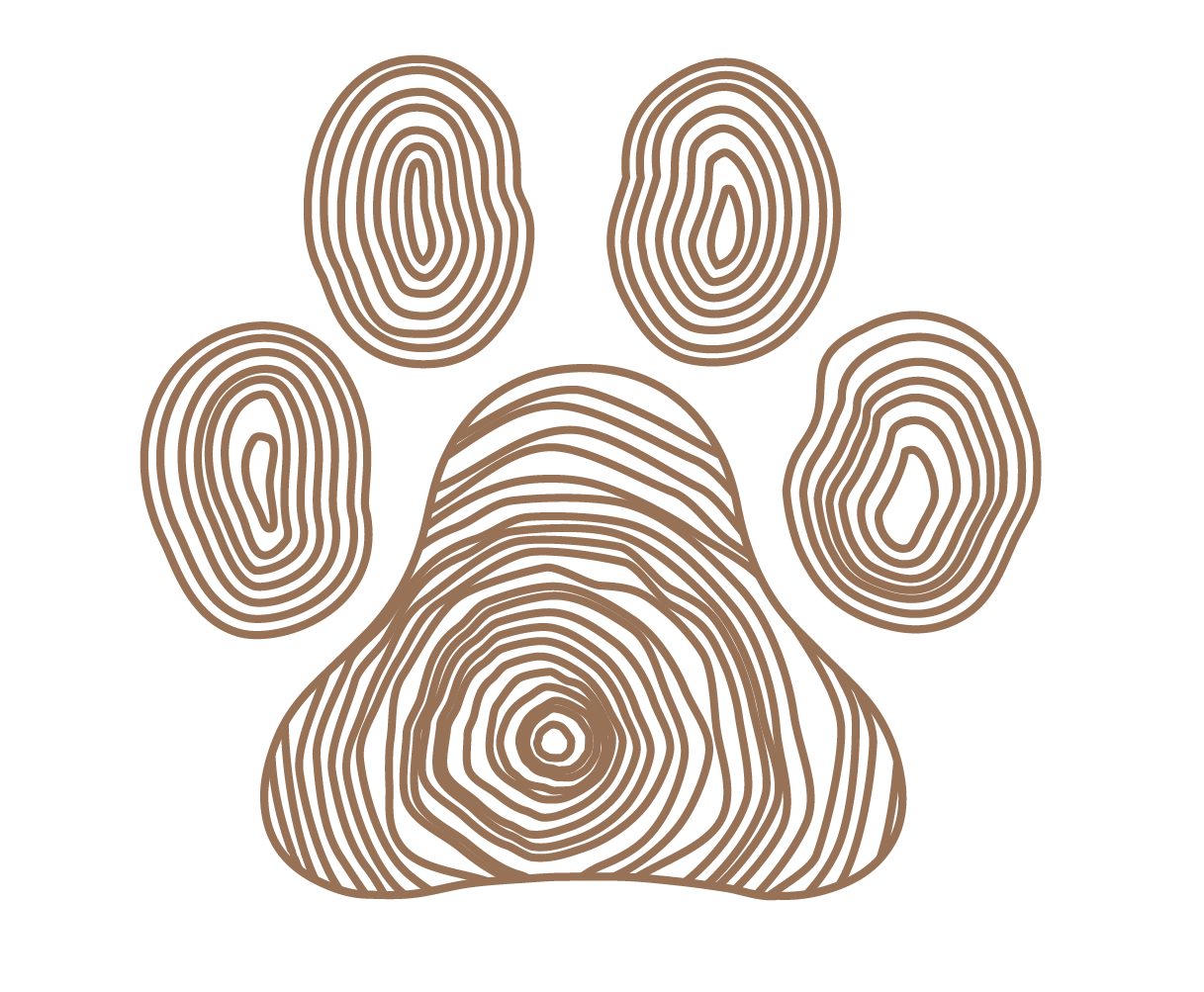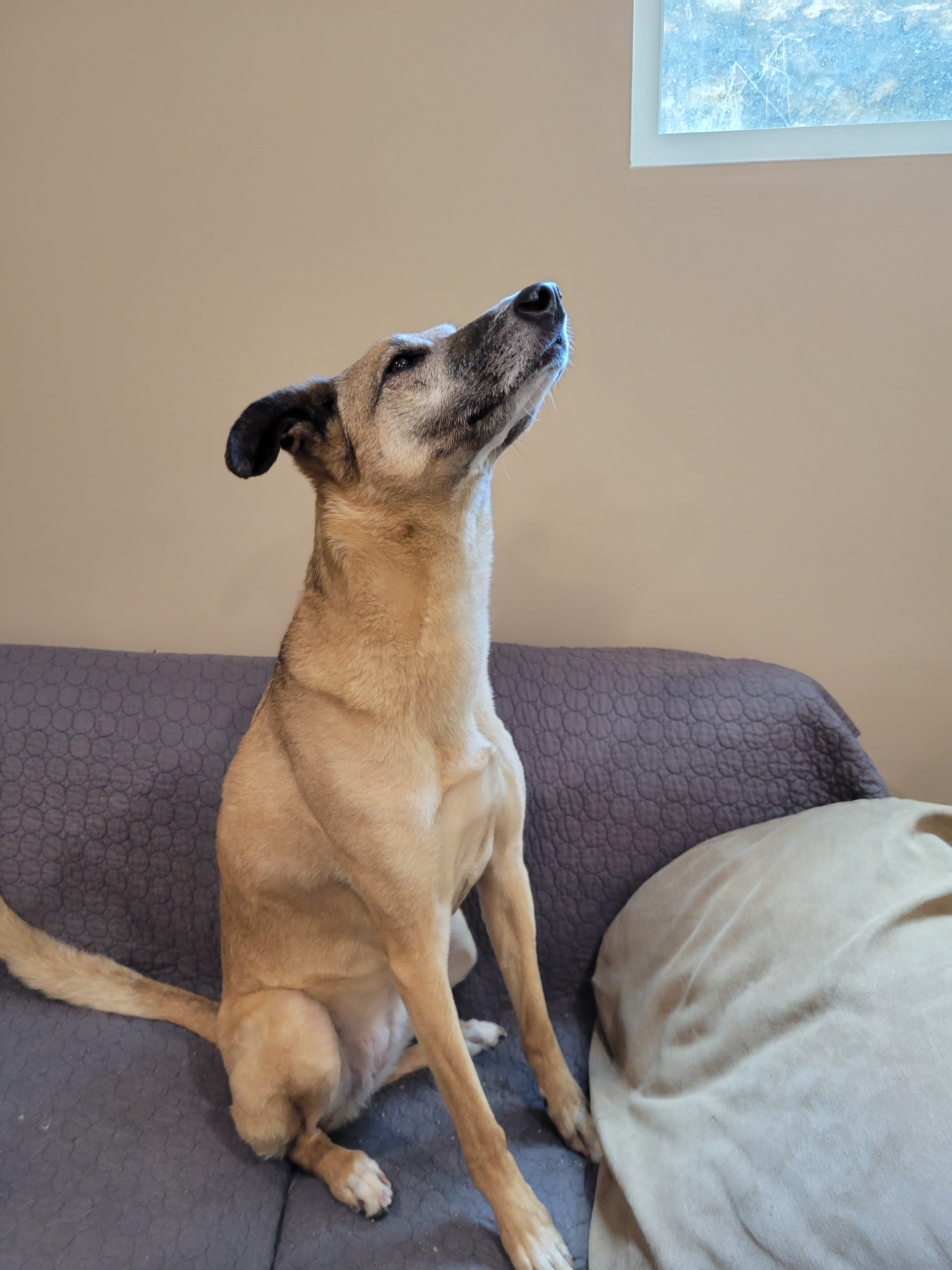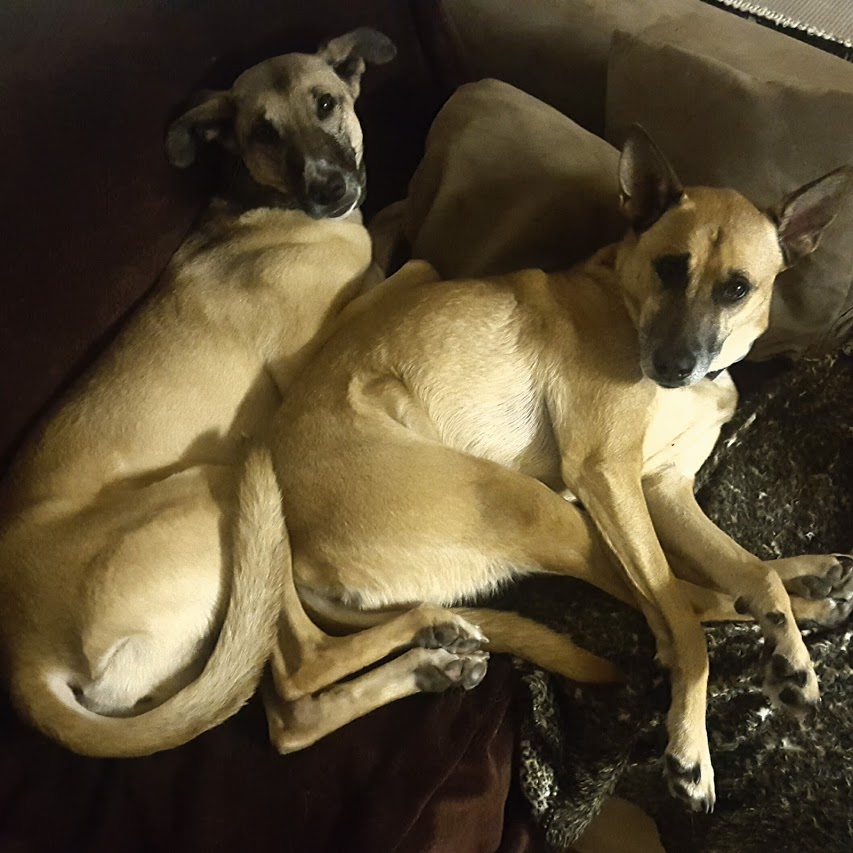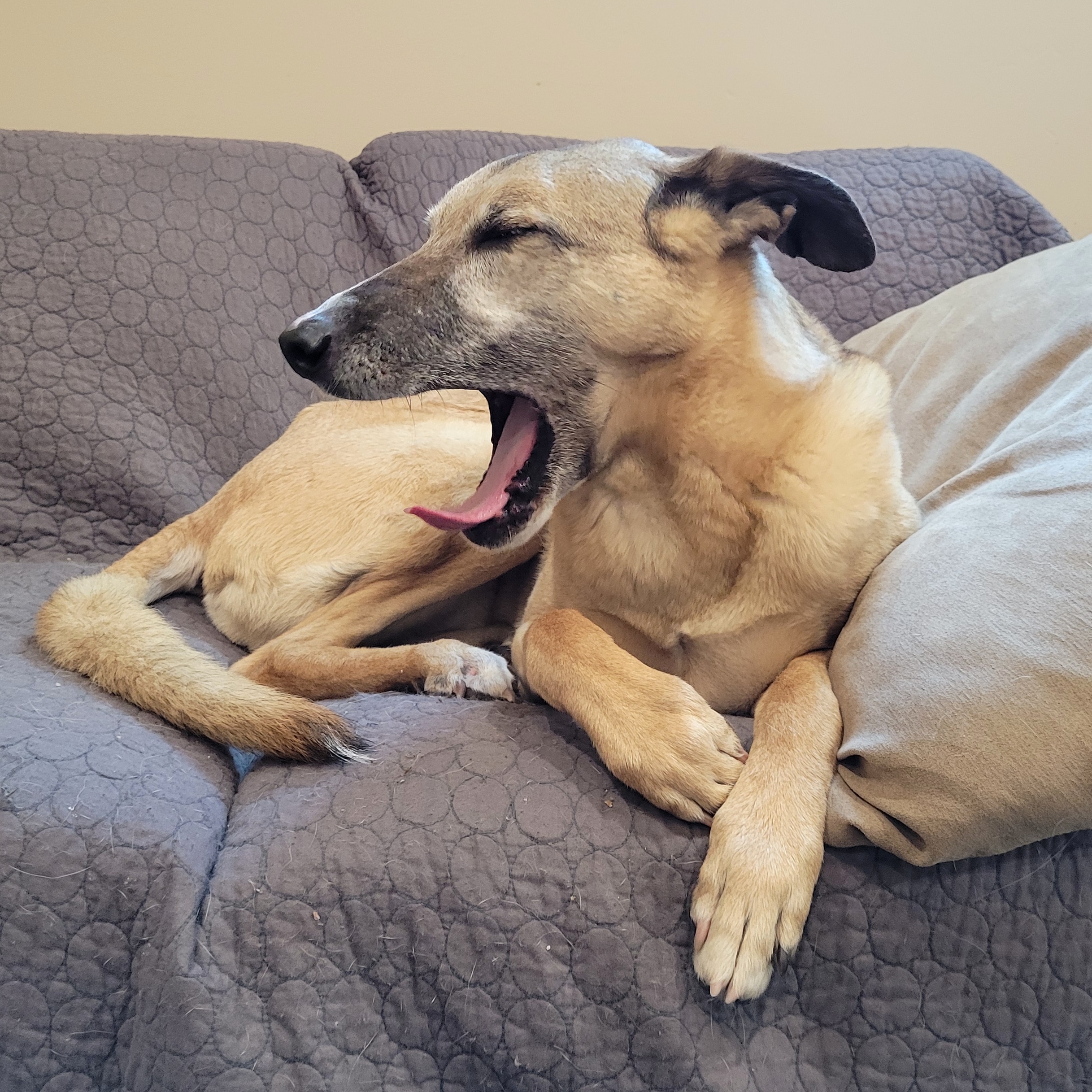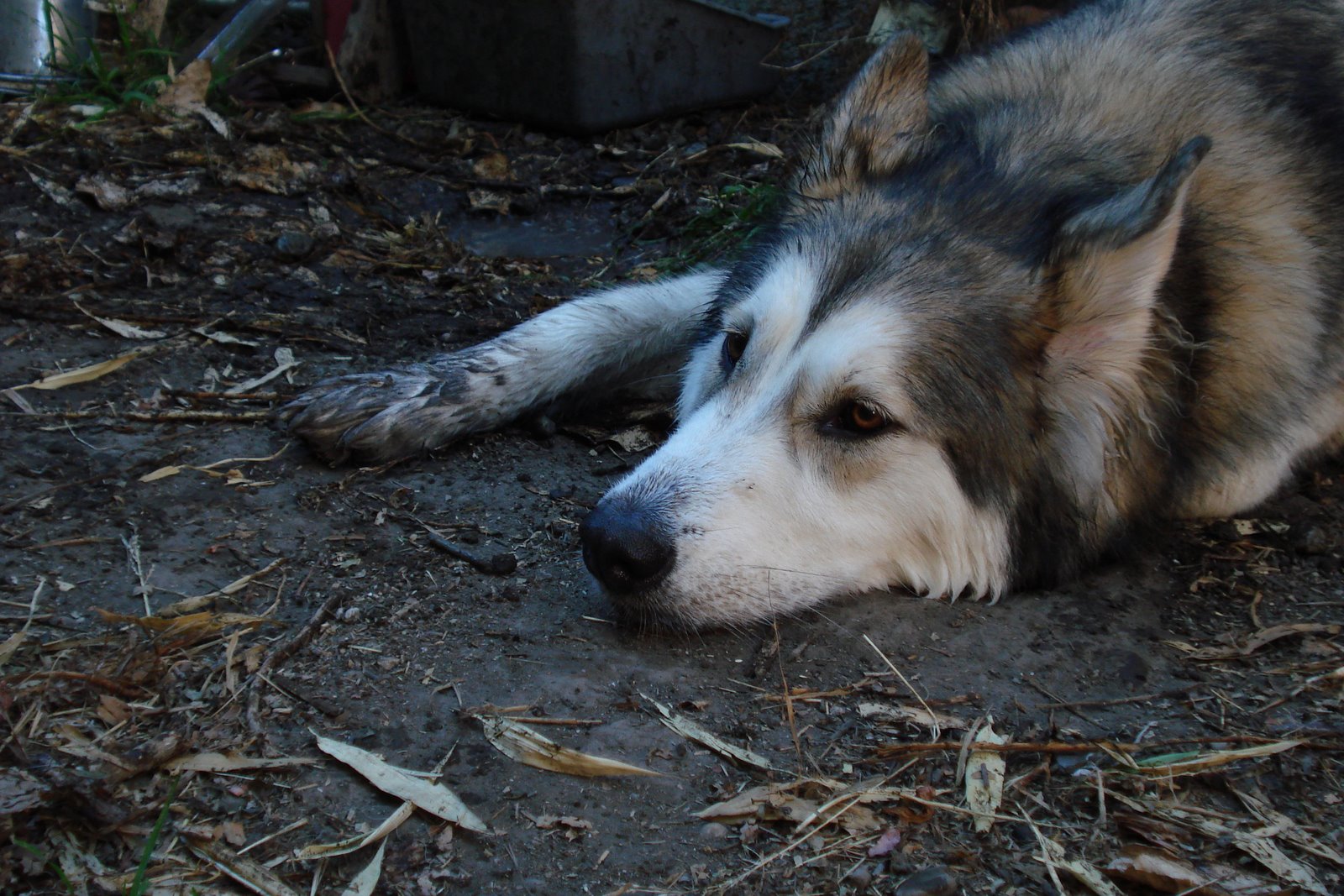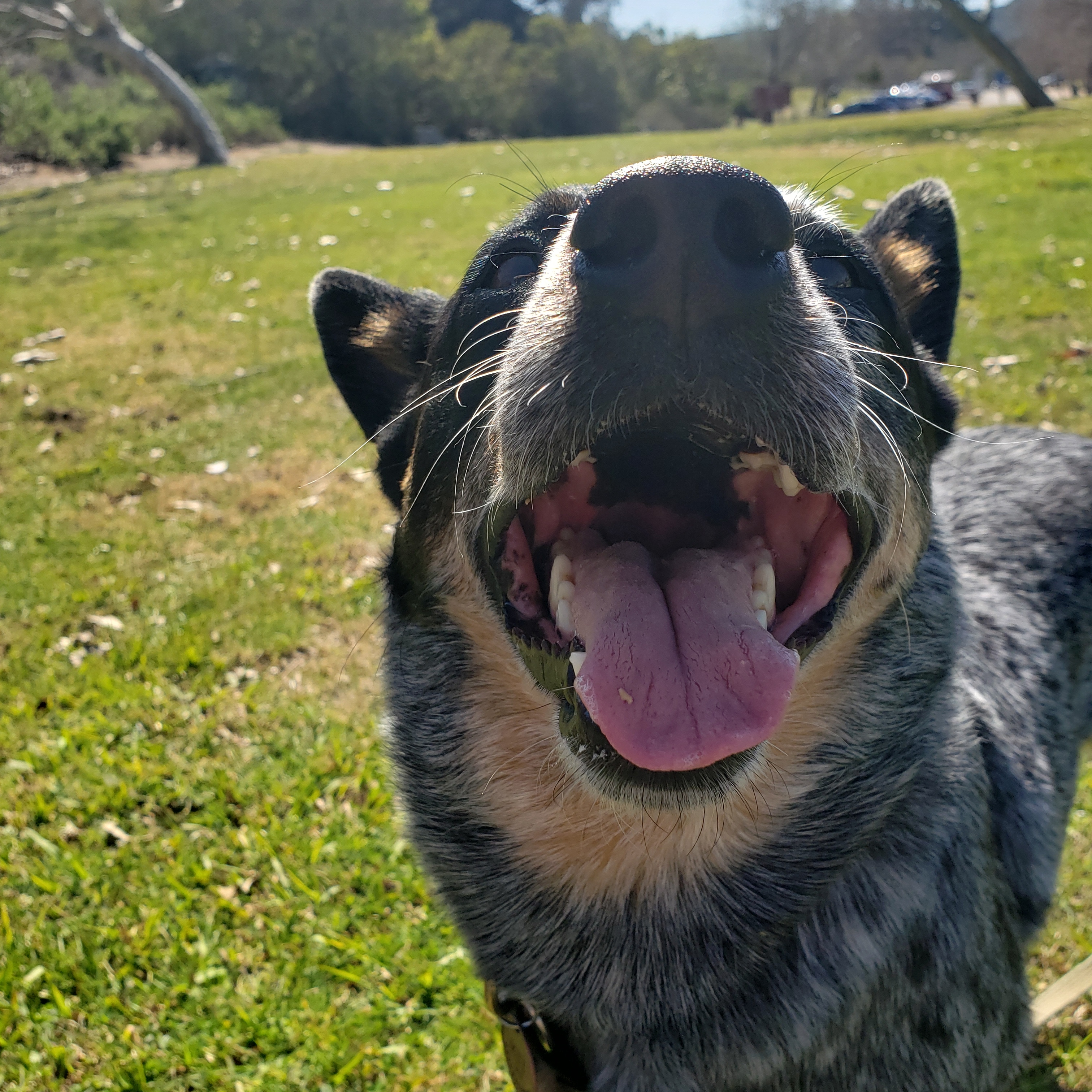In Part 2 of this series, I described how ego (Buddhist, not Freudian) can show up and insert itself into the ways we live with, train, and generally interact with our dogs, to the detriment of everyone involved. Here we will examine how to acknowledge when and where ego appears, why it’s detrimental to both ourselves and our dogs, and explore alternatives to ego-driven reactions.
In order to begin to recognize where ego is a primary motivator in our responses to our dogs and their behavior, we have to do something that many find difficult or at least unpleasant: witness our experience and feelings. It is in the examination of our interpretation of events and our emotional responses to them that we can see what is propelling those feelings into existence.
Right now I want you to think about an aspect of your dog’s behavior that you don’t like. Barking? Counter surfing? Pulling on leash? Jumping on visitors or lunging and growling at other dogs? What’s your pup’s baggage that you wish you could make disappear? Now, what emotions come up for you when you think about your dog doing that thing? Here are a few common ones: anger, shame, frustration, helplessness, exasperation, irritation. Any of these sound about right? Do you know why you feel that way?
What is it about that particular behavior or habit of your dog’s that you find so aversive?
Is the answer, “Because I don’t want my dog doing that,” “Because it’s embarrassing for me,” “Because I find it annoying,” “Because it makes walks or being in public unpleasant or difficult for me,” or something along those lines? If so, you and your ego have made your dog’s behavior about you and how these situations are negatively impacting you personally or possibly people’s perception of you.
I don’t want my dog doing that.
It’s embarrassing for me.
I find it annoying.
It makes walks unpleasant or difficult for me.
Me, me, me.
Okay, we got it: it’s about you. This is ego at work.
As a refresher, ego is our perception or construct of “self.” We suffer when our dogs’ behavior contradicts our idea of who we think we should be (or appear to be) as dog owners.* This is directly related to the Buddhist concept of attachment which I will loosely define as resistance to separating from something. In the context of this post, attachment will most frequently appear as resistance to separating from (i.e. letting go of) our ideas of how our dogs “should” behave. Our attachments to these constructs of “good” behavior are direct reflections of our egos: we hold on for dear life to our ideas of how we think our dogs should behave because of what we imagine their behavior says about us.
If you don’t believe me, here’s a situation that may resonate: When you are walking your dog, do other dogs bark at you from their windows and yards? Do you think that those dogs are doing anything that they shouldn’t or do you think that they are behaving like normal dogs? What about when your dog looks out the window or runs the fence line and barks at a passer-by? Is it a normal dog behavior now? Or is it “problem behavior”? Many if not most of us are much more judgemental about our own dogs’ behavior than about others’ because now it’s about us.
Stop Making This About You
When your primary motivation to change your dog’s behavior is for your own sake, to make your dog line up with your idea of who they should be or how they should behave, for your convenience, for your neighbors’ eyes, or for your attachment to constructs of “good” and “bad,” you are setting yourself up for suffering.
Suffering is caused not by aversive experiences, but by our own reaction to them: how we handle the unavoidable unpleasantness of life. As the saying goes, “Pain is inevitable, suffering is optional.” We are causing or increasing our own suffering when ego drives our responses to our dogs’ so-called misbehavior.
When we stop making the primary motivation for training or behavior change about us, we open a space for the critical question, why is this actually important?
Many of the things you don’t like about your dog’s behavior are legitimate concerns and absolutely should be addressed, but when your motivation to address them comes from this space of self-serving egoic need, the path to “better” behavior will be littered with obstacles of your ego’s own creation: destructive emotions, harsh actions, and closed-off perceptions and attitudes.
The Door You Walk Through Changes the Path You Walk
In a literal sense the above statement is obvious: when we alter our entry point into a physical space, the direction we move and our experience of that movement changes. You can think of a room with multiple doors, a hiking trail with multiple trailheads, or a parking garage with multiple entrances. The feel of the terrain, sights seen, sounds heard, and ease of movement from point A to point B will be affected by where you begin.
The same is true for your interactions with your dog. When you begin from the door of ego you are choosing a difficult path with more obstacles and fewer constructive emotions. This path limits opportunities to learn and grow from your experience. When you close that door and open a new one, choosing to react to your current situation from a different starting point, you can soften the experience for both yourself and your dog, reducing conflict and increasing peace.
In a world already bursting at the seams with acronyms, I am hesitant but committed to propose a new one to help clarify just how the door you walk through affects your experience of any given challenge with your dog. The door you walk through, your motivation, changes your PEACE:
Perception: How you see what is happening
Emotions: How you feel about what is happening
Attitude: The manner with which you react to the situation
Choices: Your actions and speech
Elasticity: How mentally and emotionally flexible you are during and after the event
Our perception, emotions, attitude, choices, and elasticity are all determined by our starting point. When we respond to our dogs from a place of softness our every step forward is cushioned by the tenderness of our intentions. To find that softness we must look outside ourselves to determine why behavior change is indeed important. Outside of our fragile egos, calcified attachments, and knee-jerk judgments we will find motivations that better serve not just ourselves–though we will absolutely benefit from them–but those around us… especially our dogs.
When our egos are at the center of our motivation:
Perception: The situation is seen as being only relevant in light of how it negatively impacts us. Our perspective excludes the validity of our dog’s (or others’) experience (closed perspective).
Emotions: Our emotions tend to move towards destructive feelings like frustration, anger, or shame.
Attitude: We move from a place of resistance, judgment (black and white thinking), and blame. Blame may be directed back towards ourselves manifesting as shame, or away from ourselves towards our dog (or whoever we perceived to be at fault).
Choices: Our speech to our dog, ourselves (self-talk), or even others around us will be harsh. Actions will be mechanisms to try and make the situation less aversive to us: to limit our own suffering by exerting external control, to try and make the situation look more like we think it should without acknowledging or giving weight to how our actions may affect others.
Elasticity: Low. In the moment: minimal ability to adapt or change the course of our response due to tunnel vision of ego: we are stuck on “fixing” the situation to mitigate our own discomfort (emotional or physical). After the event: minimal ability to bounce back emotionally, let alone learn or grow from the experience due to attachments to ideas of “good” and “bad.”
There’s hope, though: you can flip your brain, turn your ego on its swollen head, find new ways to perceive situations and softer, more constructive ways to respond. We just have to start from a different place.
When our PEACE is shaped by compassion, community, or relationship-based motivations we can replace the destructive path of ego with a gentler, more advantageous way to change our dogs’ behavior:
Perception: We can see multiple perspectives and hold space for the needs, wants, and emotions of others (open perspective).
Emotions: Our emotions will include care and concern for others while still allowing us to experience our own feelings about the situation.
Attitude: We are accepting of and receptive to what is happening. We are compassionate towards all involved, including ourselves.
Choices: Our speech and actions are considerate of and respectful to ourselves and our dogs.
Elasticity: High. In the moment: we are open to movement and change to allow for alternative emotional responses or courses of action because we are able to take in new information. After the event: we are able to learn from the experience without judgment of ourselves, our dogs, or others.
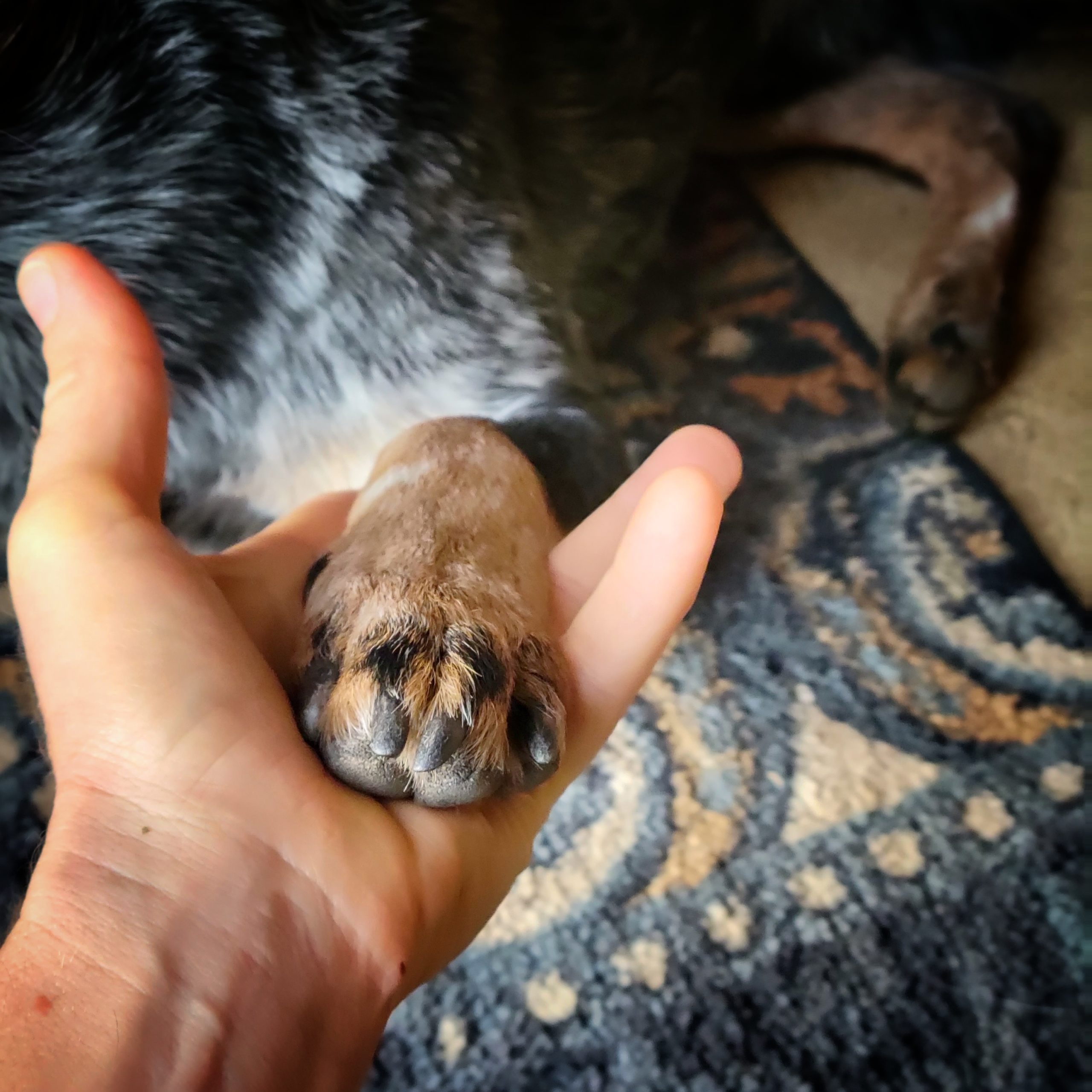
“Peacefulness should be the place we begin rather than the place we try to achieve”
-Dr Jerry Jessup, as quoted by Jill Bolte Taylor in Stroke of Insight
When Your Dog is Upset: Move From Compassion
In a previous post, I wrote about a truly terrible walk with Kit, my reactive Cattle Dog. I made it through that experience emotionally unscathed because I wasn’t thinking about myself or even how his behavior looked from the outside: I was focused on my dog’s wellbeing. More important to me at the time than my experience was that my dog made it through that walk with as little stress as possible (which was still a considerable amount) because I aimed the arrow of my actions at his emotional safety.
The driving force behind how I responded to Kit was compassion. When we find our dog’s behavior unpleasant or undesirable but can recognize that the dog’s behavior is an expression of emotional upset such as stress, fear, or even rage, it is in everyone’s best interest to respond with compassion.
Would you yell at a crying child? Or even a crying adult? Does yelling, scolding, or physically reprimanding do anything helpful for the dog’s emotional state which was the original cause of the behavior to begin with? The answer is of course no. All scolding or yelling does is make clear to ourselves, the upset party, and anyone who is watching that we don’t like what’s happening. In some cases, punishment (scolding, leash jerks, or zaps with a shock collar) may stifle the expression of emotion, but it will never soothe the emotion itself. Often, punishment actually exacerbates the dog’s level of stress, making the whole event worse for the dog this time, and subsequently trickling into added stress the next time a similar situation arises.
Here’s how it could look if I moved from an ego space when Kit reacts (and this is embarrassingly based on my own experience†):
Perception: Closed. My dog is acting in a way I don’t want – his behavior contradicts my idea of what he should be doing when he sees [other dogs, motorcycles, skateboards, mourning doves, rabbits]. I am resistant to accepting the significance of what is happening for Kit because I am focused on how it is affecting and reflecting on me.
Emotions: Frustration (dog-directed), shame (self-directed blame: if I was a better trainer he wouldn’t do this), on a bad day: anger.
Attitude: Judging both dog and self, blame – directed at Kit (he is the cause of my suffering).
Choices: Option A) forceful response: try to “fix” the dog’s external behavior through correction/punitive action – make the reactivity stop as a way to ameliorate my experience of the situation. Option B) avoidance response: remove self and dog from the situation as quickly as possible, self-talk is negative: expressions of shame and embarrassment, not being good enough.
Elasticity: Low. In the moment: tunnel vision of ego prevents the ability to see alternative choices that may be available, keeps emotional range narrow and negative. After the event: poor recovery, likely to cry in frustration (true story), will affect me (and therefore how I interact with Kit) for several hours or the rest of the day. I am unable to see ways to make it better next time because the issue is perceived as being with the inherent “goodness” of Kit or myself, and both of those remain the same.
I am endlessly grateful to whatever powers in the universe have shifted me away from that ego-centered space. If that was still how I handled Kit’s reactivity, the awful walk that I wrote about would have been a thousand times worse for both of us. Fortunately for Kit and myself, I walked through the door of compassion that day when Kit was in emotional trouble (i.e. losing his shit). Here’s how my PEACE looked:
Perception: Open. I can take in my dog’s experience and see that he is not doing well emotionally – his external behavior is a display of his current level of upset.
Emotions: Sadness, worry, frustration (situation-directed), love.
Attitude: Compassion and acceptance (of both my dog’s experience and the current situation), care and nurturing.
Choices: Protect my dog: determine and take the next right steps to support his emotional wellbeing thereby reducing his reactivity because he won’t feel as upset.
Elasticity: High. In the moment: I have the ability to alter actions/choices based on recognizing how Kit is feeling/responding to my choices. After the event: quick emotional recovery because I can rest in the knowledge that I did the best I could for him given the circumstances. When I do the best I can, that means he’s doing the best he can and I am able to recognize how I could do better for him next time.
When I moved from compassion, I was soft, I was open. I was able to take in more of reality than my own unhappiness. I was able to affect positive change in both myself and my dog because my perception had expanded beyond myself.
When Your Dog is Impacting Others – Move from Community
Often our frustrations with our dogs have to do with the way they naturally want to interact with others around them, both dogs and people. Jumping on new people and charging over to other dogs when on leash are both incredibly common complaints of dog parents (especially parents of adolescent dogs!). These behaviors are frequently the ones that people will say that their dog “shouldn’t” do because it’s “bad,” “embarrassing,” or some other reason relating to how we perceive other people judging the dog, or more accurately, judging the owner’s control over the dog.
You know what? I agree that it’s not ideal or desirable for dogs to charge up to or jump on dogs or people willy-nilly, but not because there’s some standard for dog behavior that your pup needs to live up to, not because you have a “bad” dog if they jump, or (worse!) that you “can’t control” your dog. I believe that dogs should be taught to keep all four paws on the ground when meeting new people and maintain some semblance of cool when meeting new dogs because these good manners are for the sake and safety of those at the receiving end of your dog’s exuberance.
You may be reading this thinking, “I don’t mind when my dog greets dogs or people with unbridled enthusiasm! They’re just really friendly!” Please know that even if your dog’s zeal when greeting others is friendly, even if your dog has nothing but angel-soft and innocent intentions when approaching new people or pups, it doesn’t matter. I firmly believe that you are obligated to teach your dog calmer greeting habits regardless of how friendly they are because not everyone wants your dog to say hi. There are likely millions of individuals–both human and canine–who are not comfortable being approached by dogs and, as a society, we should all respect that. Most of us have recognized that it’s wildly inappropriate to engage in well-intentioned but non-consensual touching of strangers (such as unknown people placing their hands on pregnant women’s bodies). In the same way, we should culturally acknowledge that just because you have a friendly dog does not mean you have the right to inflict your dog’s well-intentioned but non-consensual company on strangers. As the saying goes, the right to swing my leash ends where the other person’s face (or dog’s muzzle) begins.
So: whether you like your pup’s ebullient greetings or not, you are doing a service to your community, to the people and dogs around you when you coach your dog to be respectful of other individuals’ personal space bubbles. Additionally, by walking through the door of community rather than ego when you begin that coaching you are doing a service to your dog and your own PEACE.
For our example, let’s look again at the young man with the Golden Retriever I mentioned in Part 2 of this series. This young man harshly corrected his dog for moving to greet another dog while he was standing in line at a brewery. I noted that his leash jerk and scolding were likely the result of a reactive ego: the handler’s response to his dog was motivated by a knee-jerk urge to shift negative emotions and fault away from himself. Obviously, I have no idea what was actually going on in that young man’s head, but I feel that I have enough experience with frustrated pet parents to make an educated guess. Here is how I imagine his PEACE playing out:
Perception: Closed. My dog did something that I don’t like or I judge as “bad behavior.” I only see my own judgment of the situation, how the dog’s behavior reflects on me.
Emotions: Irritation, displeasure, shame/embarrassment at lack of “control.”
Attitude: Judging, disciplinary, blaming.
Choices: Take corrective action against the dog.
Elasticity: Low. In the moment: owner focused on good vs bad behavior, punishment causes immediate disruption to emotional connectivity between dog and person. After the event: human in a worse mood, dog more stressed; level of fallout dependant on sensitivity of dog and human grudge-holding.
Result: less fun for everyone.
Now let’s see how things might be different with a community-minded approach where the primary goal is physical and emotional safety for all parties:
Perception: Open. My dog is about to go into another dog’s space – I don’t know if this is okay with the other dog or the dog’s person. Awareness includes the well-being of others.
Emotions: Concern (externally directed), uncertainty.
Attitude: Responsibility, compassion for own dog’s desires and other dog’s/person’s rights to space.
Choices: Interrupt the dog’s current course in a way that is minimally aversive to the dog, increase space between dogs thereby maintaining physical/emotional safety for everyone.
Elasticity: High. In the moment: able to see multiple points of view, able to expand consciousness to include the relevance of others’ experiences and adjust actions to accommodate. After the event: connectivity between owner and dog remains same or increases due to owner’s compassionate engagement with the dog during a moment of stress. Able to ingest information about dog’s current skill set in public places and can adjust training and management accordingly. Learn to set the dog up for success in the future.
You can see how much softer this response is, not just for the dog, but for the owner as well. Negative emotions that prompt harsh actions reduce joy and connection both inside and outside oneself. When we choose to widen our perspective and include the value and relevance of others–even when we perceive our dog as being “at fault”–we create space for growth, constructive change, and greater connection.
When You Just Don’t Like It – Move from Relationship
There are some things that our dogs do that we just don’t like, and that’s okay. They’re not harmful to our dogs, they’re not harmful to the community, and they’re not harmful to us. Or, they’re not exactly harmful to us.
We all have lists of things we don’t like that aren’t harmful to anyone. Things like certain types of music, the feel of particular materials, certain activities or hobbies, and so on. These are all personal preferences, and when it comes to your dog you are certainly allowed to have preferences for their behavior the same way you are allowed to have preferences for the music you listen to.
Here are some examples of generally benign-yet-possibly-irritating dog behaviors:
Pawing at you for attention or other “demand” behaviors
Barking in excitement before a walk (I’m looking at you, Shine)
Jumping onto certain pieces of furniture
Lying in the middle of the kitchen when you’re cooking
These are small behaviors that don’t pose a risk to anyone’s well-being.
Except they kinda do. If they irritate you, they have an impact on you, how you feel about your dog at that moment, and likely how you respond to and provide feedback to your dog. That means they have an impact on your relationship with your dog.
When we take these annoying behaviors personally, when ego drives our response to them, we experience emotional hardening: closing off to our dog and our own potential growth, and (you guessed it!) less peace. When we view those small, mostly-harmless behaviors as being relevant only in terms of how we experience them, we are forgetting or discounting the relevance of the other party: the dog.
Do you think your dog is doing this thing just to get under your skin? Is this an intentional and willful act to upset you? Does your dog know they “shouldn’t” do this thing?
Guess what? Your dog is just being a dog and trying to enjoy their day the best they know how given what they have previously learned about the world they live in‡.
With that in mind, when you feel yourself getting annoyed or notice your dog doing That Thing again, if you react from ego the results of your PEACE will be harmful to your relationship with your dog.
I’ll use an example from my own life to illustrate: Shine barking (in my face) when I’m harnessing the pack up for a walk. Here’s the ego-driven reaction to this super-benign irritant:
Perception: Closed. I hate it when Shine barks like this, I find the noise grating and it’s frustrating that she won’t just be quiet. I only have room for awareness of how her barking affects me and contradicts my idea of how she should behave.
Emotions: Irritation, resentment, on a bad day: anger
Attitude: Blaming the dog for my emotions: it is Shine’s fault that I feel frustrated and powerless over her behavior. Resistant to her behavior’s validity.
Choices: Take action to attempt to control the dog through correction: scolding/verbal reprimand for barking.
Elasticity: Low. In the moment: unable to see from the dog’s perspective. Again: punishment causes immediate disruption to emotional connectivity between dog and person. After the event: start the walk in a worse mood, if Shine was scolded she is now more stressed; I am unlikely to change anything to prevent the situation from occurring again.
Now let’s look at this from a relationship-centered response:
Perception: Open. Shine is so excited for the walk that she can’t contain herself, I see her joy, but I find the noise grating.
Emotions: Conflicted: gratitude that my nearly-14-year-old dog is still thrilled by going for walks, but still annoyed by the barking.
Attitude: Acceptance of the reality of Shine’s emotions, softness to her experience as well as my own.
Choices: Either ride it out (the barking only lasts for the time it takes to get all three dogs harnessed) or engage her in a cued behavior (sit). Rewarding/feeding for Shine’s response to the cue will keep her mouth busy (chewing!).
Elasticity: High. In the moment: able to remain open to my dog’s joy while still allowing space for my own experience, able to adjust my response so as not to damage her happiness. After the event: The walk begins with gratitude (mine) and joy (hers); I am in a state of mind to think about whether I want to seek a way of preventing the barking in the future or accept it without needing to change.
This is a no-brainer, right? Do we choose frustration, grumpiness, and blame, or gratitude, joy, and acceptance?
…and it is a choice.
Between Stimulus and Response
One of my favorite quotes is this well-known gem by Viktor E. Frankel: “Between stimulus and response there is a space. In that space is our power to choose our response. In our response lies our growth and our freedom.”
When our dogs do anything that hits us as aversive we have a choice about how we respond. It doesn’t always feel like it. So, so often our responses are more like knee-jerk reactions (no different than a reactive dog too close to a trigger), but when we are able to find that space after the stimulus but before we react, we can choose to respond from a place of compassion, community, or relationship.
Our egos and their attachments to how we think our dogs should behave cover us in rigid shells that crack easily, that we are constantly trying to repair with harsh corrections and justifying judgments. These shells keep us tight and small and closed: unable to take in more or to reach out past their walls. These shells are barriers to greater connection with our dogs, to clearer communication, softer interactions, and deeper understanding.
When we let the shell of ego fall away, we can discover that we never needed it to begin with. We don’t need it to protect ourselves from feeling the sharp edges of blame, judgment, resentment, and shame when our dogs behave in ways we don’t like because ego is what causes those feelings. Ego is what prevents us from walking soft paths, seeing through clear eyes, and accepting what is.
When ego falls away from our interactions and relationships with our dogs we become unresisting and receptive–not vulnerable to greater suffering, but open and welcoming to what lies outside ourselves. As our awareness expands we learn to compassionately hold space for not just our own experience but the experiences of our dogs and others around us. In that space we can find growth, freedom, and peace.
*I personally prefer the phrase “pet parent” and I am aware that others prefer the terms “caregiver” or “guardian.” Many of us feel these are more accurate descriptors of our relationship with our dogs than “owner,” but here I believe the term “dog owner” carries the right flavor for the sentiment.
†This is a conglomeration of many, many, many moments of reactivity that I’ve experienced with Kit over the last three and a half years. I am happy to report that I (to memory) never scolded or punished Kit for reacting to dogs or fast-moving-people-on-wheels, but at one point I did try to control his reactivity to mourning doves through what I thought of at the time as a low-level “aversive interrupter”–which I believed at the time was not based on emotional upset. I used a quick jerk on his leash (attached to a harness) to interrupt the behavior. That was an ill-thought-out and short-lived experiment in using low-level punishment and it made both Kit and me more unhappy. It was also the act of a desperate and overwhelmed dog mom. I have 20/20 hindsight here.
More often than not, specifically with his dog reactivity, my behavioral response to a reactive episode (or the threat of a reactive episode) was to high-tail it away, mentally muttering to myself such gems as “fuckfuckfuckfuck” which I can translate to: this isn’t what I want, I should be a better trainer, this isn’t the dog I wanted, I hate being that guy in the neighborhood, everyone must think I’m an idiot with no control over my dog, I have no control over my dog.
‡I’m not going to go into a whole treatise on unintentionally or intermittently reinforced behaviors that set both pups and pup parents up for stress and frustration, but the concept is relevant here and worth exploring for your and your dog’s sake.
